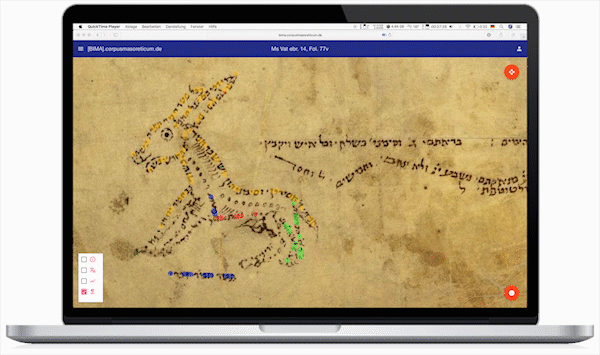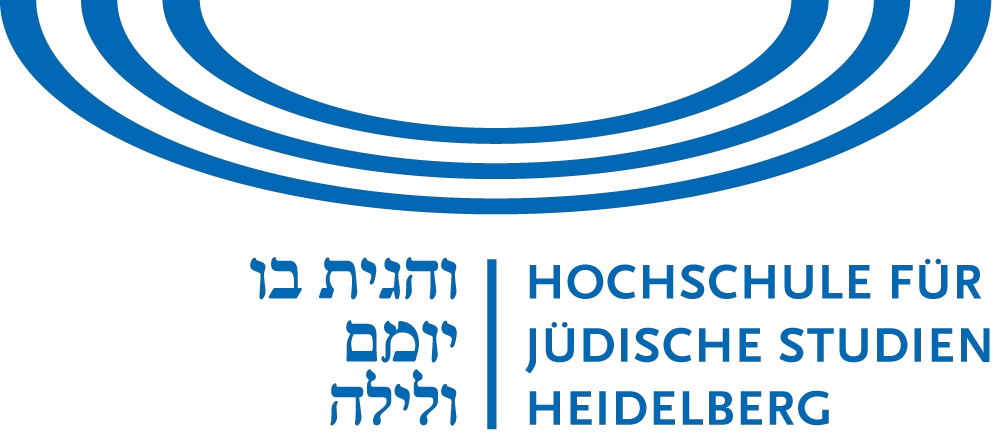B04 |
Scholarly Knowledge, Drollery or Esotericism? The Masora of the Hebrew Bible in its Various Material Properties |
current staff members
| Teilprojektleiterin | Prof. Dr. Hanna Liss |
| akademischer Mitarbeiter | Dr. Dr. Federico Dal Bo |
former staff members
| akademische Mitarbeiterin | Dr. Elodie Attia |
| akademischer Mitarbeiter | Kay Joe Petzold |
| akademische Mitarbeiterin | Hanna-Barbara Rost |
| akademischer Mitarbeiter | Clemens Liedtke |
| akademischer Mitarbeiter | Jonas Leipziger |
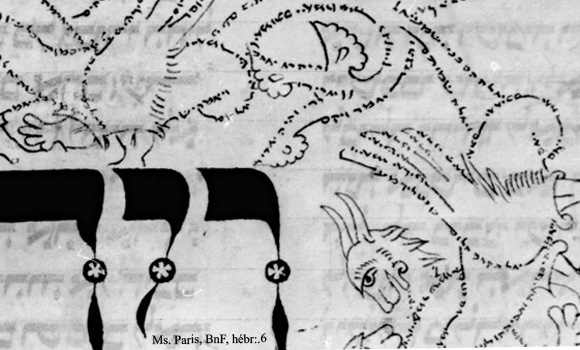
In seiner dritten Förderphase widmet sich das Teilprojekt B04 dem Wechsel von der Handschrift zum Druck und untersucht insbesondere die Weitergabe von handschriftlichen und gedruckten Artefakten zur Masora. Der Druck prägte dabei eine Text- und Layout-Tradition der Masora aus, in der die ashkenasische Tradition – gekennzeichnet durch eine vielgestaltige masora figurata – sukzessive zugunsten der weniger aufwändig gestalteten sefardischen verdrängt wurde.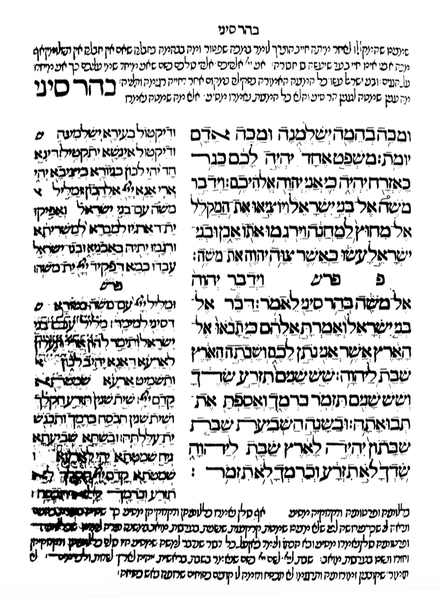
Das Projekt nimmt die Inkunabeln und frühen Drucke sowie ihre Manuskript-Geschwister in den Blick und fragt nach Rezeption und Bedeutung der Masora, nach den Akteuren der Buchproduktion (Drucker; Schreiber) und ihren veränderten sozialen Feldern (Synagoge; Universität) sowie abschließend nach den bis heute relevanten philologischen Konsequenzen, die der Buchdruck mit der Etablierung einer standardisierten Masora mit sich brachte. Hierin werden auch erstmals die seit den ersten Universitäten getrennten akademischen Felder der Bibel(-text-)forschung und der Judaistik/Jüdische Studien wieder zusammengeführt.
Der praxeologische Blick auf die Produktion der hebräischen Bibeln und auf die damit verbundene Präsentation der Masora in der liminalen Phase des frühen hebräischen Buchdruckes zwischen 1475 und 1500 erscheint insbesondere deshalb so spannend, weil der Wegfall der masora figurata aus den ashkenasischen Bibelmanuskripten des 11. bis 14. Jahrhunderts keineswegs isoliert auftrat. Vielmehr ging er mit einem Wechsel des Beschreibstoffes (Papier neben Pergament), der Ausdifferenzierung und/oder dem Wechsel von Produzenten und Rezipienten ([christliche und jüdische] Drucker anstelle jüdischer Schreiber; christliche Hebraisten; jüdische Gelehrte) sowie mit einer großen Variabilität in Textbestand und -umfang, Layout und Lagenbindung einher. Allerdings war dies keine abrupte Entwicklung: Mit dem Ausgang des 15. Jahrhunderts treten in Italien und auf der iberischen Halbinsel neben die handschriftliche Überlieferung die ersten Inkunabel-Drucke der Hebräischen Bibel und der etablierten hebräischen Kommentarliteratur. In diesen frühen Drucken lässt sich ein differenziertes Neben- und Miteinander des Bibeltextes (als Hypotext) und seinen verschiedenen Kommentierungen (als Hypertexte) beobachten: Bibelkommentar(e), Targum sowie masoretische Notationen.
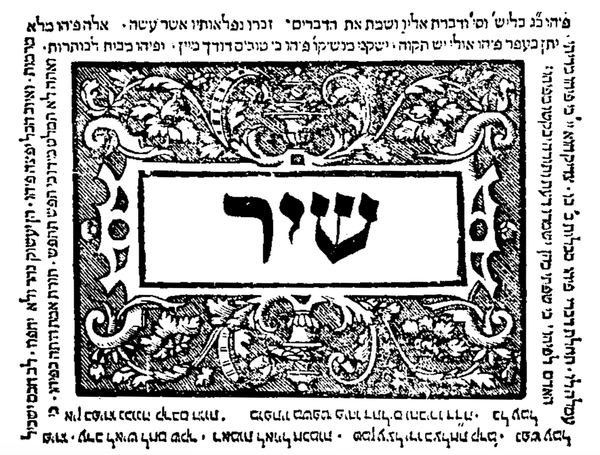
Anhand des Vergleiches zwischen den Bibelhandschriften und den frühen Drucken des 15. Jahrhunderts erarbeitet das Projekt grundlegende Ergebnisse hinsichtlich der wechselseitigen Rezeption ashkenasischer und sefardischer Texttraditionen (Oberitalien) und sefardisch-tiberiensischer Textraditionen (Spanien/Portugal), die mit dem Verlust ashkenasischer Masora-Traditionen zu Beginn des typographischen Zeitalters in der ersten Hälfte des 16. Jahrhunderts einherging. Darüber hinaus liefert es vor allem praxeologisch relevante Ergebnisse hinsichtlich der Affordanz der Artefakte mit Blick auf ihre liturgischen und/oder wissenschaftlichen Nutzungsmöglichkeiten.
Tagungen, Kolloquien, Workshops 2011-15
November 2011
Workshop Erscheinungsbild und Handhabung heiliger Schriften (organisiert von den TPen A03, A05, B02, B04, B07, C04 und C07)
März 2013
Heidelberg Symposium of Medieval History, Universität Heidelberg.
Juli / August 2013
Panel beim World Congress of Jewish Studies, Jerusalem und der International Organisation of Masoretic Studies IOMS
November 2013
Konferenz an der Hochschule für Jüdische Studien Heidelberg: Text-Image Relationship and Visual Elements in Written Hebrew Sources from the Middle Ages to Early Modern Period.
Dezember 2013
Workshop in Paris, Journee d'Etude, EPHE.
Juli 2014
Paris, Sorbonne, Xth Congress of the European Association for Jewish Studies (Massora Session).
Juli bis Oktober 2017
Multimedia Exhibition in the Synagogue of Worms: Galgal. Elements of Creation in Motion Computer-Animated Presentation of Ornamental-Figurative Micrography Taken from Medieval Bible Manuscripts and Displayed in a Cultic Space, Worms Synagogue (www.galgal.de).
August 2017
Panel beim World Congress of Jewish Studies, Jerusalem.
Februar 2018
Konferenz an der Hochschule für Jüdische Studien Heidelberg: Material Aspects of Reading (organisiert von den Typen B05 und C02; Programm).
Mai 2018
Projekt-Workshop an der Hochschule für Jüdische Studien Heidelberg: Philology and Aesthetics (Programm).
Juli 2018
Panel auf dem Kongress der European Association of Jewish Studies, Kraków.
Vorträge der einzelnen aktuellen und ehemaligen Mitarbeiter*innen finden Sie zudem auf deren Profilseiten.
Publikationen
Online
- Liss, Hanna/Petzold, Kay Joe/Liedtke, Clemens (seit 2016): Digitale Edition der Masora Figurata in MS Vat. ebr. 14 (Online: bima.corpusmasoreticum.de & http://bima2.corpusmasoreticum.de/manuscripts).
- Attia, Elodie, „Targum Layouts in Ashkenazi manuscripts. Preliminary methodological observations“, in: Alberdina Houtman, Hans-Martin Kirn und Eveline van Staalduine-Sulman (Hgg.), A Jewish Targum in a Christian World, Leiden, 2014, 99–122.
- Attia, Elodie, The Masorah of Elijah ha-Naqdan, an Edition of Ashkenazic Micrographical Notes (Ms. Vat. Ebr. 14, Book of Exodus) (MTK 11), Berlin/München/Boston 2015.
- Attia, Elodie, „Editing Ashkenazic Masorah and Micrography“, Sefarad 75 (2015), 7-33.
- Krauß, Anna/Leipziger, Jonas/Schücking-Jungblut, Friederike (Hgg.), Material Aspects of Reading. Materiality, Performance and Presence of the Written Word in Ancient and Medieval Cultures (MTK 26), Berlin/Boston 2019 [im Erscheinen].
- Leipziger, Jonas, „Ancient Jewish Greek Practices of Reading and their Material Aspects“, in: Anna Krauß, Jonas Leipziger und Friederike Schücking-Jungblut (Hgg.), Material Aspects of Reading. Materiality, Performance and Presence of the Written Word in Ancient and Medieval Cultures (MTK 26), Berlin/Boston 2019 [im Erscheinen].
- Liss, Hanna, „Gelehrtenwissen, Drôlerie oder Esoterik? Erste Überlegungen zur Masora der Hebräischen Bibel in ihren unterschiedlichen materialen Gestaltungen im Hochmittelalter“, in: Nathanael Riemer (Hg.), Jewish Lifeworlds and Jewish Thought. Festschrift presented to Karl E. Grözinger on the Occasion of his 70th Birthday, Wiesbaden 2012, 27-40.
- Liss, Hanna, „‘Like a Camel Carrying Silk:’ Initial Considerations on the Use of the Masorah in Medieval Hebrew Commentaries“, in: Ra'anan Boustan u.a. (Hgg.),Envisioning Judaism: Studies in Honor of Peter Schäfer on the Occasion of his Seventieth Birthday, Tübingen 2013, 1121-1137.
- Liss, Hanna, „Hebraica Veritas? Jüdische Bibelauslegung, wissenschaftliche Bibelforschung und die alt-neue Frage nach ihrer Kommunikation“, in: Karl Kardinal Lehmann und Ralf Rothenbusch (Hgg.),Gottes Wort in Menschenwort. Die eine Bibel als Fundament der Theologie (QD 266), Freiburg u.a. 2014, 337-356.
- Liss, Hanna, „Vom Sefer Tora zum sefer: Die Bedeutung von Büchern im ‚Buch der Frommen‘ des R. Yehuda ben Shemu’el he-Ḥasid“, in: Joachim Friedrich Quack und Daniela Christina Luft (Hgg.), Erscheinungsformen und Handhabungen Heiliger Schriften (MTK 5), Berlin/München/Boston 2014, 179-199.
- Liss, Hanna, „Ein Pentateuch wie andere auch? Die Lese-Geheimnisse des Regensburg Pentateuch“, in: Friedrich Emanuel Focken und Michael Ott (Hgg.), Metatexte. Erzählungen von schrifttragenden Artefakten in der alttestamentlichen und mittelalterlichen Literatur (MTK 15), Berlin/München/Boston 2016.
- Liss, Hanna, „‚Daneben steht immer ein kluger Kopf‘: Die Glossenformationen im Codex Wien hebr. 220“, in: Hanns Peter Neuheuser, Ralf M. W. Stammberger und Matthias M. Tischler (Hgg.), Diligens scrutator sacri elogii. Schriftauslegung als Grundfunktion mittelalterlicher Gesellschaft und Geschichte. Festschrift für Rainer Berndt SJ, Münster 2016, 53-85.
- Liss, Hanna, „A Pentateuch to Read in? The Secrets of the Regensburg Pentateuch“, in: Irina Wandrey (Hg.), Jewish Manuscript Cultures. New Perspectives (Studies in Manuscript Cultures 13), 2017, 89–128.
- Liss, Hanna, „Aschkenasische Bibelcodices als Träger exegetischer und theologischer Geheimnisse“, in: Ursula Schattner-Rieser u. Josef M. Oesch (Hgg.) 700 Jahre jüdische Präsenz in Tirol. Geschichte der Fragmente, Fragmente der Geschichte, Innsbruck 2018, 203–223.
- Liss, Hanna, „Scepticism, Critique, and the Art of Writing: Preliminary Considerations on the Question of Textual Authority in Medieval Peshaṭ Exegesis“, in: Yearbook of the Maimonides Centre for Advanced Studies 2018 (hg. v. Bill Rebiger), Berlin/Boston: De Gruyter, 2018, 15–45 (open access: https://doi.org/10.1515/9783110577686-003).
- Liss, Hanna, „‚Die niedere Kritik‘: Das Studium der Masora zwischen Wissenschaft des Judentums und Bibelwissenschaft“, in: Deutsch-jüdische Bibelwissenschaft Historische, exegetische und theologische Perspektiven (hg. v. Daniel Vorpahl, Shani Tzoref und Sophia Kähler; Europäisch-jüdische Studien – Beiträge 40), Berlin: De Gruyter/Oldenbourg, 2019, 139–159 (online: https://doi.org/10.1515/9783110551631-010).
- Liss, Hanna, „Introduction: Editorial State of the Art of the Masoretic Corpus and Research Desiderata“, in: Philology and Aesthetics. Figurative Masorah in Western European Manuscripts (hg. v. Hanna Liss in Zusammenarbeit mit Jonas Leipziger; Judentum und Umwelt 85), Frankfurt am Main et al.: Peter Lang, 2021, 7–33.
- Liss, Hanna, “Masorah as Counter-Crusade? The Use of Masoretic List Material in MS London, British Library Or. 2091”, in: Philology and Aesthetics. Figurative Masorah in Western European Manuscripts (hg. v. Hanna Liss in Zusammenarbeit mit Jonas Leipziger; Judentum und Umwelt 85), Frankfurt am Main et al.: Peter Lang, 2021, 131–175.
- Liss, Hanna, “Negation oder Transformation? Illustrative Auflösung masoretischer Listen in einem mittelalterlichen hebräischen Manuskript,” in (Nicht)Wissen – Dynamiken der Negation in vormodernen Kulturen, ed. by Şirin Dadaş und Christian Vogel (Wiesbaden: Harrassowitz, 2021), 313–330.
- Liss, Hanna, “Teaching in Tiny Letters. Eliyyah ben Berekhyah ha-Naqdan’s Way of Teaching as Displayed in MS Biblioteca Apostolica Vaticana ebr. 14,” Corpus Masoreticum Working Papers 1, 2022, 1–20 (https://journals.ub.uni-heidelberg.de/index.php/cmwp).
- Liss, Hanna/Petzold, Kay Joe, „Die Erforschung der westeuropäischen Bibeltexttradition als Aufgabe der Jüdischen Studien“, in: Andreas Lehnardt (Hg.), Judaistik im Wandel. Ein halbes Jahrhundert Forschung und Lehre über das Judentum in Deutschland, Berlin/München/Boston 2017, 189–210.
- Petzold, Kay Joe, Masora und Exegese. Untersuchungen zur Masora und Bibeltextüberlieferung im Kommentar des R. Schlomo ben Yitzchaq (Raschi) (MTK 24), Berlin/München/Boston (erscheint 2019)
- Petzold, Kay Joe, „Die Kanaan-Karten des R. Salomo Ben Isaak (Raschi) – Bedeutung und Gebrauch mittelalterlicher hebräischer Karten-Diagramme“, in: Das Mittelalter 22,2 (2017), 332–350.
Die Mitarbeiter*innen des Teilprojekts beteiligten sich außerdem an zwei Artikeln im Sammelband MTK 1: Edition; Layouten und Gestalten.

